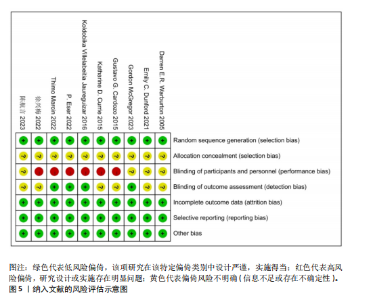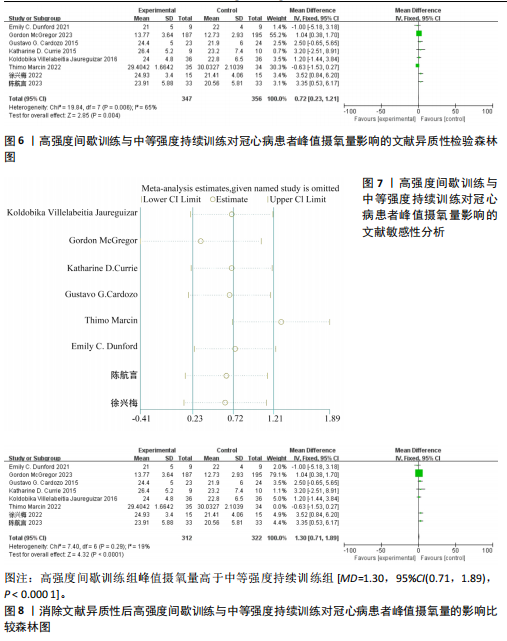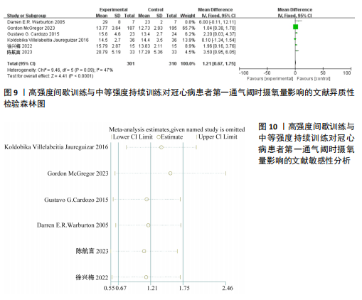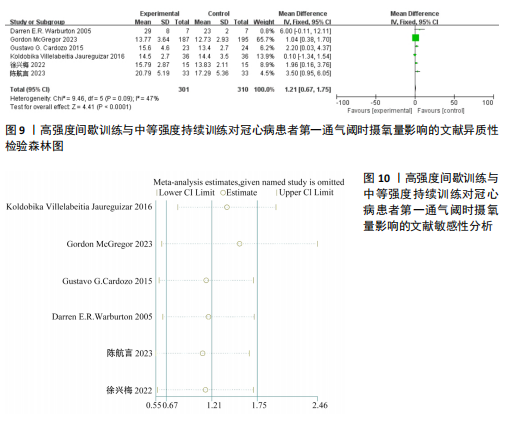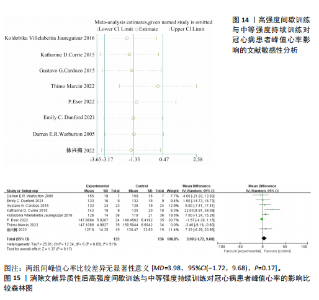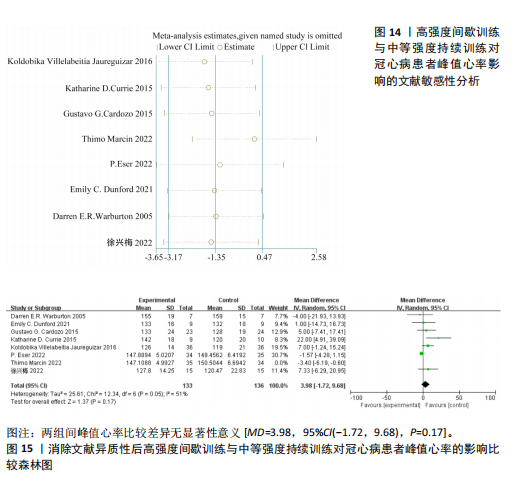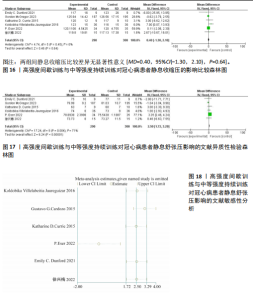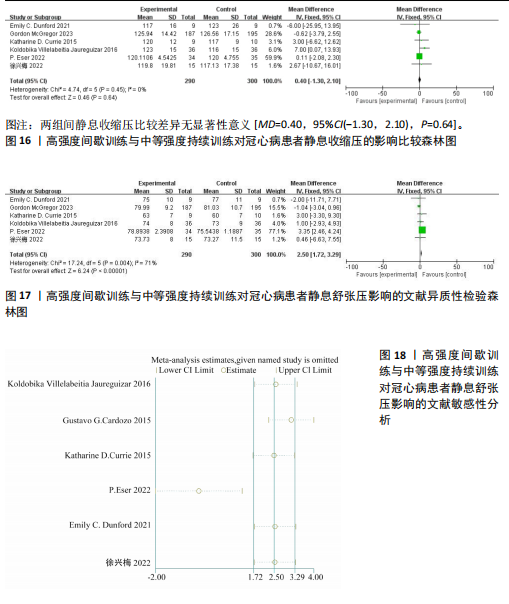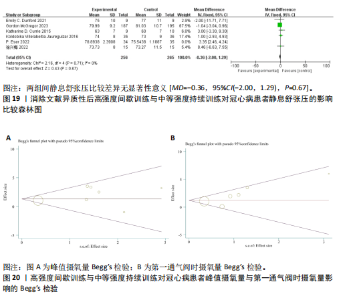Chinese Journal of Tissue Engineering Research ›› 2026, Vol. 30 ›› Issue (10): 2584-2593.doi: 10.12307/2026.625
Previous Articles Next Articles
Meta-analysis of the clinical efficacy of high-intensity interval exercise and middle-intensity continuous training in patients with coronary heart disease
Hu Yujie1, Xie Ping1, 2, Lu Weijie3, Yang Kang3, Deng Yaoting3, Liu Mengyang3
- 1The First Clinical Medical College of Lanzhou University, Lanzhou 730000, Gansu Province, China; 2Guansu Provincial People’s Hospital, Lanzhou 730000, Gansu Province, China; 3Gansu University of Chinese Medicine, Lanzhou 730000, Gansu Province, China
-
Received:2025-04-03Accepted:2025-06-08Online:2026-04-08Published:2025-08-30 -
Contact:Xie Ping, PhD, Chief physician, Professor, Doctoral supervisor, The First Clinical Medical College of Lanzhou University, Lanzhou 730000, Gansu Province, China; Guansu Provincial People’s Hospital, Lanzhou 730000, Gansu Province, China -
About author:Hu Yujie, MS candidate, The First Clinical Medical College of Lanzhou University, Lanzhou 730000, Gansu Province, China -
Supported by:Gansu University of Chinese Medicine Innovation and Entrepreneurship Program, No. 2025CXZX-917 (to LWJ)
CLC Number:
Cite this article
Hu Yujie, Xie Ping, , Lu Weijie, Yang Kang, Deng Yaoting, Liu Mengyang. Meta-analysis of the clinical efficacy of high-intensity interval exercise and middle-intensity continuous training in patients with coronary heart disease[J]. Chinese Journal of Tissue Engineering Research, 2026, 30(10): 2584-2593.
share this article
Add to citation manager EndNote|Reference Manager|ProCite|BibTeX|RefWorks
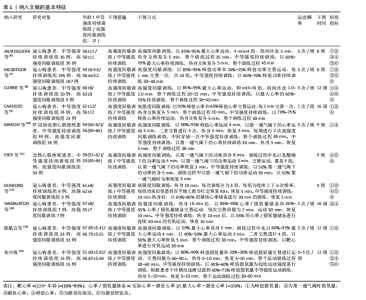
2.1 文献检索结果 根据纳入与排除标准,最终纳入10篇文献进行Meta分析[6-15]。纳入的10项临床研究中,患者年龄为55-70岁,缺乏对年轻患者的代表性,这可能影响结果在年轻人群中的适用性;此外,纳入研究的地域分布以中高收入国家为主,缺乏来自低收入国家的数据,由于医疗资源和生活方式的差异,结果可能无法完全适用于低收入国家的患者。文献筛选流程见图3。 2.2 纳入研究的基本特征和质量评价 纳入研究的基本特征见表1。应用Review Manager 5.3软件依照Cochrane风险偏倚评分工具对纳入的10篇文献进行质量评价,结果显示所有文献在分配隐藏方面并未做出明显说明,由于试验性质要求,无法达"

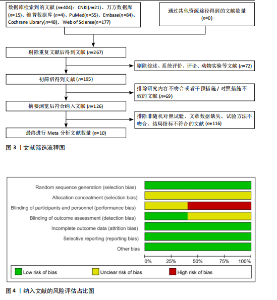
到受试者盲法与结果评估者双盲,但其中4篇文献明确提及对结果评估者采用盲法;所有研究均未发现数据缺如、选择性报告研究成果及其他偏倚来源。文献质量评价结果见图4,5。 2.3 Meta分析结果 2.3.1 峰值摄氧量 8篇文献报道了高强度间歇训练干预对冠心病患者峰值摄氧量的影响[6-10,12,14-15]。异质性检验显示P=0.006、I2=65%,见图6,提示文献之间存在明显异质性。对文献进行敏感性分析,结果提示MARCIN等[10] 文章对总体效应量影响较大,见图7,剔除该篇文章后再次进行异质性检验,结果显示P=0.29、I2=19%,提示文献之间异质性消除。采用固定效应模型计算效应量,结果显示高强度间歇训练组峰值摄氧量高于中等强度持续训练组[MD=1.30,95%CI(0.71,1.89),P < 0.000 1],见图8。 2.3.2 第一通气阈时摄氧量 6篇文献报道了高强度间歇训练干预对冠心病患者第一通气阈时摄氧量的影响[6-7,9,13-15]。异质性检验显示P=0.09、I2=47%,见图9,提示文献之间存在轻微异质性。经敏感性分析未发现存在明显影响总体效应量的文章,并且文献之间异质性在可接受范围内,见图10,因此选用随机效应模型计算效应量,结果提示高强度间歇训练组第一通气阈时摄氧量高于中等强度持续训练组[MD=1.54,95%CI(0.56,2.53),P=0.002],见图11。 2.3.3 静息心率 5篇文献报道了高强度间歇训练干预对冠心病患者静息心率的影响[6-8,12,15]。异质性检验显示P=0.23、I2=28%,提示文献之间不存在异质性,故选用固定效应模型计算效应量,结果显示两组间静息心率比较差异无显著性意义[MD=0.92,95%CI(-0.77,2.62),P=0.29],见图12。 2.3.4 峰值心率 8篇文献报告了高强度间歇训练干预对冠心病患者峰值心率的影响[6,8-13,15]。异质性检验显示P=0.03、I2=56%,见图13,提示文献之间存在异质性。敏感性分析结果显示,MARCIN等[10]的文章对总体效应量影响较大,剔除该篇文章后异质"
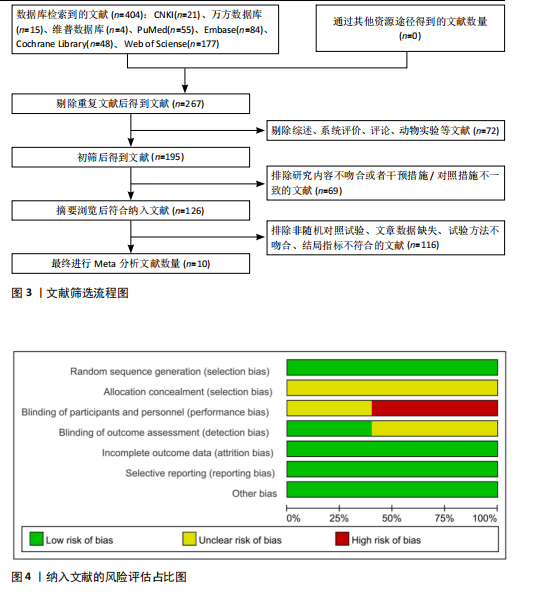
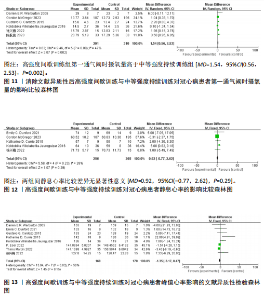
性无法消除(P=0.05、I2=51%),见图14,故选用随机效应模型计算效应量,结果显示两组间峰值心率比较差异无显著性意义[MD=3.98,95%CI (-1.72,9.68),P=0.17],见图15。 2.3.5 静息收缩压 6篇文献报道了高强度间歇训练干预对患者静息静息收缩压的影响[6-8,11-12,15]。异质性检验显示P=0.45、I2=0%,提示文献之间无异质性,故选用固定效应模型计算效应量,结果显示两组间静息收缩压比较差异无显著性意义[MD=0.40,95%CI(-1.30,2.10),P=0.64],见图16。 2.3.6 静息舒张压 6篇文献报道了高强度间歇训练干预对患者静息舒张压的影响[6-8,11-12,15]。异质性检验显示P=0.004、I2=71%,见图17,提示文献之间存在较强异质性。敏感性分析显示,ESER等[11]的文章对总体效应量影响较大,见图18。剔除该篇文献后再次进行异质性检验(P=0.71、I2=0%),文献之间异质性消除,故选用固定效应模型计算效应量,结果显示两组间静息舒张压比较差异无显著性意义[MD=-0.36,95%CI(-2.00,1.29),P=0.67],见图19。 2.3.7 发表偏倚检验 此次研究所选取的结局指标中,仅峰值摄氧量、第一通气阀时摄氧量2个指标具有统计学意义,针对此两项指标,应用StataMP 17软件分别进行Begg’s检验,结果显示2个指标均不存在发表偏倚,见图20,这一结果支持此次研究结论的可靠性,减少了因选择性发表导致的潜在偏差,为评估患者预后提供了更准确的依据。"
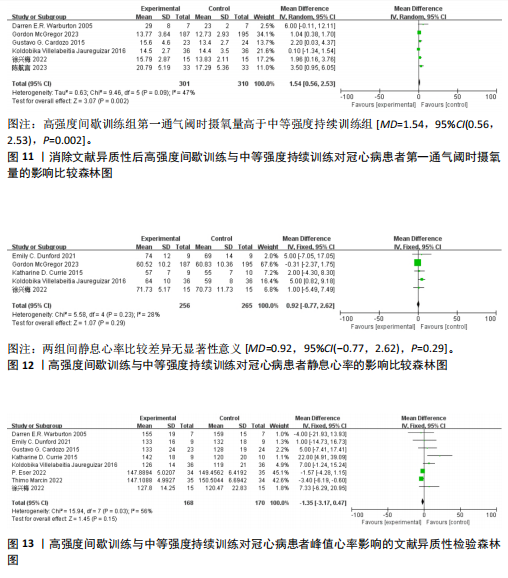
| [1] YANG Q, WANG L, ZHANG X, et al. Impact of an enhanced recovery after surgery program integrating cardiopulmonary rehabilitation on post-operative prognosis of patients treated with CABG: protocol of the ERAS-CaRe randomized controlled trial. BMC Pulm Med. 2024;24(1):512-534. [2] FENG S, LI M, FEI J, et al. Ten-year outcomes after percutaneous coronary intervention versus coronary artery bypass grafting for multivessel or left main coronary artery disease: a systematic review and meta-analysis. J Cardiothorac Surg. 2023;18(1): 54-65. [3] DUN Y, THOMAS RJ, MEDINA-INOJOSA JR, et al. High-Intensity Interval Training in Cardiac Rehabilitation: Impact on Fat Mass in Patients With Myocardial Infarction. Mayo Clin Proc. 2019;94(9):1718-1730. [4] YU AKD, KILIC F, DHAWAN R, et al. High-Intensity Interval Training Among Heart Failure Patients and Heart Transplant Recipients: A Systematic Review. Cureus. 2022;14(1):e21333. [5] OKAMURA M, SHIMIZU M, YAMAMOTO S, et al. High-intensity interval training versus moderate-intensity continuous training in patients with heart failure: a systematic review and meta-analysis. Heart Fail Rev. 2023;28(5):1113-1128. [6] JAUREGUIZAR KV, VICENTE-CAMPOS D, BAUTISTA LR, et al. Effect of High-Intensity Interval Versus Continuous Exercise Training on Functional Capacity and Quality of Life in Patients With Coronary Artery Disease: A RANDOMIZED CLINICAL TRIAL. J Cardiopulm Rehabil Prev. 2016;36(2):96-105. [7] MCGREGOR G, POWELL R, BEGG B, et al. High-intensity interval training in cardiac rehabilitation: a multi-centre randomized controlled trial. Eur J Prev Cardiol. 2023; 30(9):745-755. [8] CURRIE KD, BAILEY KJ, JUNG ME, et al. Effects of resistance training combined with moderate-intensity endurance or low-volume high-intensity interval exercise on cardiovascular risk factors in patients with coronary artery disease. J Sci Med Sport. 2015;18(6):637-642. [9] CARDOZO GG, OLIVEIRA RB, FARINATTI PT. Effects of high intensity interval versus moderate continuous training on markers of ventilatory and cardiac efficiency in coronary heart disease patients. Sci World J. 2015;2015:192479. [10] MARCIN T, TRACHSEL LD, DYSLI M, et al. Effect of self-tailored high-intensity interval training versus moderate-intensity continuous exercise on cardiorespiratory fitness after myocardial infarction: A randomised controlled trial. Ann Phys Rehabil Med. 2022;65(1):101490. [11] ESER P, JAEGER E, MARCIN T, et al. Acute and chronic effects of high-intensity interval and moderate-intensity continuous exercise on heart rate and its variability after recent myocardial infarction: A randomized controlled trial. Ann Phys Rehabil Med. 2022;65(1): 01444. [12] DUNFORD EC, VALENTINO SE, DUBBERLEY J, et al. Brief Vigorous Stair Climbing Effectively Improves Cardiorespiratory Fitness in Patients With Coronary Artery Disease: A Randomized Trial. Front Sports Act Liv. 2021;3:630912. [13] WARBURTON DE, MCKENZIE DC, HAYKOWSKY MJ, et al. Effectiveness of high-intensity interval training for the rehabilitation of patients with coronary artery disease. Am J Cardiol. 2005;95(9): 1080-1084. [14] 陈航言,韦丽华,钟美容,等.高强度间歇训练对老年冠心病患者认知衰弱的影响[J].中国实用护理杂志,2023,39(8): 587-592. [15] 徐兴梅.HIIT对稳定性冠心病患者心脏自主神经功能及抑郁心理的影响[D].昆明:昆明医科大学,2022. [16] CAMPBELL WW, KRAUS WE, POWELL KE, et al. High-Intensity Interval Training for Cardiometabolic Disease Prevention. Med Sci Sports Exerc. 2019;51(6):1220-1226. [17] YIN M, LI H, BAI M, et al. Is low-volume high-intensity interval training a time-efficient strategy to improve cardiometabolic health and body composition? A meta-analysis. Appl Physiol Nutr Metab. 2024;49(3):273-292. [18] YU H, ZHAO X, WU X, et al. High-intensity interval training versus moderate-intensity continuous training on patient quality of life in cardiovascular disease: a systematic review and meta-analysis. Sci Rep. 2023; 13(1):13915. [19] ROMERO-VERA L, ULLOA-DÍAZ D, ARAYA-SIERRALTA S, et al. Effects of High-Intensity Interval Training on Blood Pressure Levels in Hypertensive Patients: A Systematic Review and Meta-Analysis of Randomized Clinical Trials. Life (Basel). 2024;14(12):1661-1675. [20] ZHANG X, XU D, SUN G, et al. Effects of high-intensity interval training in patients with coronary artery disease after percutaneous coronary intervention: A systematic review and meta-analysis. Nurs Open. 2021;8(3): 1424-1435. [21] YANG Y, LV Q, ZHANG X, et al. Effects of high-intensity interval training on cardiorespiratory function in coronary artery disease: An overview of systematic reviews. Ann Phys Rehabil Med. 2024;68(2):101878. [22] MITCHELL BL, LOCK MJ, DAVISON K, et al. What is the effect of aerobic exercise intensity on cardiorespiratory fitness in those undergoing cardiac rehabilitation? A systematic review with meta-analysis. Br J Sports Med. 2019;53(21):1341-1351. [23] TAYLOR JL, BONIKOWSKE AR, OLSON TP. Optimizing Outcomes in Cardiac Rehabilitation: The Importance of Exercise Intensity. Front Cardiovasc Med. 2021;8:734278. [24] LETNES JM, DALEN H, VESTERBEKKMO EK, et al. Peak oxygen uptake and incident coronary heart disease in a healthy population: the HUNT Fitness Study. Eur Heart J. 2019;40(20):1633-1639. [25] CARBONE S, KIM Y, KACHUR S, et al. Peak oxygen consumption achieved at the end of cardiac rehabilitation predicts long-term survival in patients with coronary heart disease. Eur Heart J Qual Care Clin Outcomes. 2022;8(3):361-367. [26] GOMES-NETO M, DURÃES AR, CONCEIÇÃO LSR, et al. High-intensity interval training versus moderate-intensity continuous training on exercise capacity and health-related quality of life in patients with coronary artery disease: An updated systematic review and meta-analysis. Braz J Phys Ther. 2025;29(1):101137. [27] MILANI JGPO, MILANI M, CIPRIANO GFB, et al. Exercise intensity domains determined by heart rate at the ventilatory thresholds in patients with cardiovascular disease: new insights and comparisons to cardiovascular rehabilitation prescription recommendations. BMJ Open Sport Exerc Med. 2023;9(3):e001601. [28] DU L, ZHANG X, CHEN K, et al. Effect of High-Intensity Interval Training on Physical Health in Coronary Artery Disease Patients: A Meta-Analysis of Randomized Controlled Trials. J Cardiovasc Dev Dis. 2021;8(11): 158-176. [29] YUE T, WANG Y, LIU H, et al. Effects of High-Intensity Interval vs. Moderate-Intensity Continuous Training on Cardiac Rehabilitation in Patients With Cardiovascular Disease: A Systematic Review and Meta-Analysis. Front Cardiovasc Med. 2022;9:845225. [30] SULTANA RN, SABAG A, KEATING SE, et al. The Effect of Low-Volume High-Intensity Interval Training on Body Composition and Cardiorespiratory Fitness: A Systematic Review and Meta-Analysis. Sports Med. 2019;49(11):1687-1721. [31] 陈琴,张培珍.不同运动方式对高血压的影响[J].中华高血压杂志(中英文),2024, 32(8):787-795. [32] SARVASTI D, LALENOH I, OEPANGAT E, et al. Cardiovascular Protection Variables Based on Exercise Intensity in Stable Coronary Heart Disease Patients After Coronary Stenting: A Comparative Study. Vasc Health Risk Manag. 2020;16:257-270. [33] EDWARDS JJ, DEENMAMODE AHP, GRIFFITHS M, et al. Infographic. Exercise training and resting blood pressure: a large-scale pairwise and network meta-analysis of randomised controlled trials. Br J Sports Med. 2023;57(20):1335-1336. [34] NAYOR M, XANTHAKIS V, TANGUAY M, et al. Clinical and Hemodynamic Associations and Prognostic Implications of Ventilatory Efficiency in Patients With Preserved Left Ventricular Systolic Function. Circ Heart Fail. 2020;13(5):e006729. [35] JOU J, ZHOU X, LINDOW T, et al. Heart rate response and recovery in cycle exercise testing: normal values and association with mortality. Eur J Prev Cardiol. 2025;32(1):32-42. [36] FOX K, FORD I, STEG PG, et al. Heart rate as a prognostic risk factor in patients with coronary artery disease and left-ventricular systolic dysfunction (BEAUTIFUL): a subgroup analysis of a randomised controlled trial. Lancet. 2008; 372(9641):817-821. [37] 戴华,苗德军,赵黎明,等.静息心率与老年冠心病关系的研究[J].中华老年心脑血管病杂志,2012,14(9):937-938. [38] ROH J, RHEE J, CHAUDHARI V, et al. The Role of Exercise in Cardiac Aging: From Physiology to Molecular Mechanisms. Circ Res. 2016;118(2):279-295. [39] WANG H, LIU Z, SHAO J, et al. Immune and Inflammation in Acute Coronary Syndrome: Molecular Mechanisms and Therapeutic Implications. J Immunol Res. 2020;2020:4904217. [40] LAWLER PR, BHATT DL, GODOY LC, et al. Targeting cardiovascular inflammation: next steps in clinical translation. Eur Heart J. 2021;42(1):113-131. [41] SAMUEL M, TARDIF JC, BOUABDALLAOUI N, et al. Colchicine for Secondary Prevention of Cardiovascular Disease: A Systematic Review and Meta-analysis of Randomized Controlled Trials. Can J Cardiol. 2021;37(5): 776-785. [42] BANI HANI DA, ALSHRAIDEH JA, SALEH A, et al. Lymphocyte-based inflammatory markers: Novel predictors of significant coronary artery disease. Heart Lung. 2024; 70:23-29. [43] MANGALESH S, DUDANI S, MAHESH NK. Development of a Novel Inflammatory Index to Predict Coronary Artery Disease Severity in Patients With Acute Coronary Syndrome. Angiology. 2024;75(3):231-239. [44] VESTERBEKKMO EK, AKSETØY IA, FOLLESTAD T, et al. High-intensity interval training induces beneficial effects on coronary atheromatous plaques: a randomized trial. Eur J Prev Cardiol. 2023;30(5):384-392. |
| [1] | Yang Qiongqiong, Liu Wei. Comparison of performance and clinical effects of zirconia and titanium implants [J]. Chinese Journal of Tissue Engineering Research, 2026, 30(8): 2063-2071. |
| [2] | Wang Zhenze, Liu Fende, Zhang Rui, Li Wujun. Mesenchymal stem cells in treatment of arteriosclerosis obliterans of lower extremities: systematic review and meta-analysis [J]. Chinese Journal of Tissue Engineering Research, 2026, 30(7): 1869-1876. |
| [3] | Chen Qiang, Wu Wenjuan, Jiang Shuhua, Huang Da. Physical exercise improves physical function in burn patients: a systematic review and meta-analysis [J]. Chinese Journal of Tissue Engineering Research, 2026, 30(5): 1269-1281. |
| [4] | Jiang Yang, Peng Hao, Song Yanping, Yao Na, Song Yueyu, Yin Xingxiao, Li Yanqi, Chen Qigang. Isometric exercise reduces resting blood pressure: a meta-analysis of moderating factors and dose effects [J]. Chinese Journal of Tissue Engineering Research, 2026, 30(4): 975-986. |
| [5] | Li Hanyue, Li Yini, Xiang Linmei, Li Sen. Effects of resistance exercise therapy on pain and function in patients with cervical spondylotic radiculopathy: a meta-analysis [J]. Chinese Journal of Tissue Engineering Research, 2026, 30(4): 987-996. |
| [6] | Sun Jiahe, Shi Jipeng, Zhu Tianrui, Quan Helong, Xu Hongqi. Effect of exercise intervention in elderly individuals with sarcopenia and its comorbidities: a meta-analysis [J]. Chinese Journal of Tissue Engineering Research, 2026, 30(4): 997-1007. |
| [7] | Wang Yalei, Wang Xuezhi, Zhou Tao, Shen Xinxin, Fang Ding, Chen Hongliang. Effect of sacroiliac joint ankylosis on outcomes of L5/S1 transforminal lumbar interbody fusion and lumbar sagittal parameters [J]. Chinese Journal of Tissue Engineering Research, 2026, 30(3): 634-641. |
| [8] | Liao Guangtao, Feng Ziyu, Fu Xiaoyong, Zhao Qinglan, Chen Chao, Hong Jinsong. Subtalar arthroereisis for treatment of pediatric flexible flatfoot: relationship between radiographic indicators and clinical efficacy [J]. Chinese Journal of Tissue Engineering Research, 2026, 30(3): 661-670. |
| [9] | Gao Shiai, Yu Zifu, Chen Jinhui, Cao Xinyan, Leng Xiaoxuan, Liu Xihua. Efficacy of non-invasive neuromodulation techniques on autism spectrum disorder: a network meta-analysis [J]. Chinese Journal of Tissue Engineering Research, 2026, 30(10): 2550-2559. |
| [10] | Tang Zhuolin, Yin Mingyue, Bai Mingyang, Zheng Huakun, Yan Henghao, Xu Kai, Liu Qian. Effects of high-intensity interval training and moderate-intensity continuous training on cognitive function in patients with neurodegenerative diseases: a meta-analysis [J]. Chinese Journal of Tissue Engineering Research, 2026, 30(10): 2594-2607. |
| [11] | Sun Yundi, Cheng Lulu, Wan Haili, Chang Ying, Xiong Wenjuan, Xia Yuan. Effect of neuromuscular exercise for knee osteoarthritis pain and function: a meta-analysis [J]. Chinese Journal of Tissue Engineering Research, 2025, 29(9): 1945-1952. |
| [12] | Wang Yida, Liu Jun, Wang Xiaoling, Wang Liyan, Yang Chengru, Zhang Xuexiao. Effects of wearable electronic device-based interventions on physical activity and sedentary behavior in healthy adolescents: a meta-analysis [J]. Chinese Journal of Tissue Engineering Research, 2025, 29(8): 1693-1704. |
| [13] | Zhang Zixian, Xu Youliang, Wu Shaokui, Wang Xiangying. Effects of blood flow restriction training combined with resistance training on muscle indicators in college athletes: a meta-analysis [J]. Chinese Journal of Tissue Engineering Research, 2025, 29(8): 1705-1713. |
| [14] | Wang Juan, Wang Guanglan, Zuo Huiwu. Efficacy of exercise therapy in the treatment of anterior cruciate ligament reconstruction patients: #br# a network meta-analysis #br# [J]. Chinese Journal of Tissue Engineering Research, 2025, 29(8): 1714-1726. |
| [15] | Zheng Huakun, Yin Mingyue, Liu Qian. Effects of interval and continuous training on the quality of life in physically inactive adults: a meta-analysis [J]. Chinese Journal of Tissue Engineering Research, 2025, 29(8): 1727-1740. |
| Viewed | ||||||
|
Full text |
|
|||||
|
Abstract |
|
|||||
